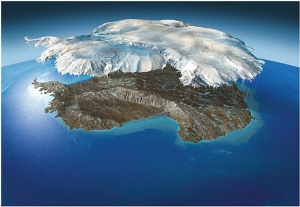Did you know that the sea level would rise 60 meters if all the ice in Antarctica were to melt?
But an ice-free Antarctia would never come to pass unless the entire continent were to move, and that would take millions of years. This means that the Antarctic continent’s contribution to global sea level is much less than 60 meters. But figuring out just how much less is a difficult task that the world’s scientists are currently striving to accomplish.
 The Antarctic continent is vast, and holds an incredible amount of water, in the form of ice. Illustration: Norwegian Polar Institute
The Antarctic continent is vast, and holds an incredible amount of water, in the form of ice. Illustration: Norwegian Polar Institute
Ten years ago, the general opinion among scientists was that the Antarctic Ice Cap would increase in mass if global temperatures rose. This is because higher air temperatures would lead to more precipitation – and in frigid Antarctica, that means more snow. As a result, the ice cap would grow thicker. The snow that falls over Antarctica binds water that would otherwise be in the oceans. Thus the conjecture was that during global warming, Antarctica would contribute towards a decrease in sea level.
More recent measurements taken from satellites and on the ground have prompted reconsideration of this conclusion. Antarctica is a continent covered with ice, and most of that ice is high above sea level. Where the ice cap meets the sea, however, vast floating ice shelves form: these shelves contain about 10 % of the ice in Antarctica. The ice shelves are in contact with the ocean, which can weaken and melt them. Along the Antarctic Peninsula in particular, several ice shelves have collapsed in the past decade. Ice shelves serve as a kind of stopper, holding back the land-based ice farther inland. When ice shelves disappear, the seaward movement of land-based ice accelerates. The consequence is more glacial calving and more icebergs – icebergs that eventually melt and raise the sea level.
The uncertainties surrounding what will happen to the ice in Antarctica during this century are many. Several new research findings indicate that before 2100, Antarctica will contribute between 10 and 50 cm of the total increase in sea level.